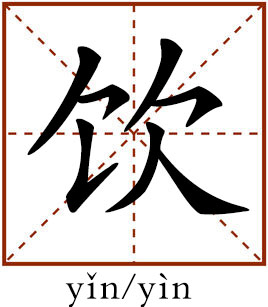Drink

When pronounced as yǐn, this character means “to drink.” When pronounced as yìn, it means “to give water to livestock.”
如人饮水 冷暖自知
rú rén yǐn shuǐ, lěng nuǎn zì zhī
Ru means “like, as” and ren “human.” Yin means “to drink” and shui “water.” Leng nuan means “cold and warm.” Zi refers to oneself and zhi “to know.” This term means that only the one drinking water knows if it is cold or hot.
This term originated from Huangboshan Duanjichanshi Chuanxinfayao (Essentials of the Transmission of Mind by Master Huangbo Xiyun), a collection of the Buddhist teachings of Huangbo Xiyun, an influential Chinese master of Zen Buddhism during the Tang Dynasty, recorded by his student Pei Xiu.
For Master Huangbo, being able to verify and harmonize one’s mind with another enlightened mind is first and foremost to experience and realize one’s own enlightenment. This experience and realization of one’s own enlightenment is like a person drinking water. Whether the water is cold or warm, one must experience it by oneself. This is the Buddhist interpretation of this term.
In recent years, this term became popular, and is often used to express difficulties fully understanding others’ minds, and their feelings about life or experiences, because everyone’s life is more complicated than it appears, and sometimes it’s difficult to let the others know what you are going through, particularly in crisis.
The mind is its own place. Therefore, there is often a touch of sadness and helplessness in this term today. For example, some married people seem to be happier than the others, some jobs seem to pay more than the others. However, what you see of others may just be the bright side. These people still have their own troubles and difficulties, which others couldn’t understand.
At this point, the term “only the one drinking water knows if it is cold or hot” could be used to describe this subtle situation. The meaning of this term can be extended to the idea “never judge a person by his or her appearance.”
Edited by REN GUANHONG

 PRINT
PRINT CLOSE
CLOSE